
The Canon, Text, and Manuscripts of the New Testament
By Charles Fremont Sitterly
PART I - THE CANON OF THE NEW TESTAMENT
Traced from the latest Version of the English Bible through the Latin and Greek to the original writers
Introduction
|
The New Testament, as we now have it, and as it has existed from the beginning of its separate and corporate life, comprises, doubtless, the best of early Christian literature. Although there is many an Apocalypse, Epistle, Book of Apostolic Acts, and even Gospel (see list below), belonging to the early Christian centuries which is profitable for comparative study, yet it is safe to predict that none of these will ever rank with those which we do receive and account as canonical. Partial List of New Testament Literature Outside the Canon
Of this list, which might be more than duplicated in the single field of Apocryphal Lives of Christ, only 6, 7, 9, 10, 11, and 13 ever approximated even local or temporary canonicity. It is to be observed that, taken as a whole, the New Testament Apocrypha does not rise, either in doctrinal or literary value, to the apocryphal books of the Old Testament. "The first work of biblical criticism is to investigate the canon of the Bible, and to determine, so far as possible, the entire extent and the exact limit of Holy Scripture."1 The New Testament canon neither is nor ever has been so vital a problem in biblical literature as the canon of the Old Testament. Doubtless, not the least of the reasons for this is the fact that the entire group of New Testament writings sprang into existence within the century and almost within the lifetime of "those who were from the beginning eyewitnesses and ministers of the word." It is, however, a pleasing thing and profitable to trace back the finished product as far as possible to its original sources. According to the articles of the faith of Christendom, "all the books of the New Testament as they are commonly received we do receive and account canonical." Our first inquiry, then, in taking up the study of the New Testament is as to why the twenty-seven books, comprising the second part of the Bible, are commonly received and accounted canonical. The word "canon" in Greek, which is one of the most interesting terms in either Greek, Latin, or English, will here be used in a sense which is almost last and least in significance, namely, to denote the list or catalogue of New Testament books. Bishop Westcott rightly remarks that the sixteenth century was the first occasion on which the general subject of the canon was debated as a question of doctrine in the Catholic Church. For consideration of the three views which found dogmatic expression from that time, namely, that of the Romanists, the Lutherans, and the Calvinists, and "the truth which each embodies and exaggerates," the master work of Westcott must be read.2 Doubtless, the days of active controversy are now past, and the questions of how, where, and when this classic library of Christian writings came into being can be clearly traversed with fewer words than ever before. Like many of its constituent books, the library itself is found to be the result of a long process of growth, but the outstanding facts are easily discerned.
|
|
 |
 |
|
1) C. S. Briggs, The Study of Holy Scripture, p. 116. 2) B. F. Westcott, On the Canon of the New Testament, p. 466.
|
|
-
Site Navigation
 Home
Home What's New
What's New Bible
Bible Photos
Photos Hiking
Hiking E-Books
E-Books Genealogy
Genealogy Profile
Free Plug-ins You May Need
Profile
Free Plug-ins You May Need
 Get Java
Get Java.png) Get Flash
Get Flash Get 7-Zip
Get 7-Zip Get Acrobat Reader
Get Acrobat Reader Get TheWORD
Get TheWORD